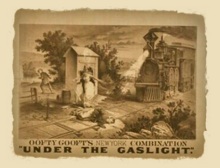Bronson Howard (aka the Dean of the American Drama) was born in Detroit, MI. As a young man he made the decision to forgo an education at Yale for the excitement of newspaper journalism in New York City. Howard always felt that there was a great void in American theatre . He wanted to write dramas about everyday American life at a time when British dramas were all the rage. Howard had his first success with Saratoga:Pistols For Seven, produced in 1870 by Augustin Daly. It was wildly popular and ran for over 100 nights at the Fifth Avenue Theatre in New York, a rare achievement for an American playwright. The success of Saratoga influenced other native playwrights and started to change the face of late 19th century American theatre.
On March 23,1877 Nannary’s company (including Lizzie May and George) produced Howard’s play Saratoga at the Academy of Music in Halifax. It was a comedic society drama in five acts.
Saratoga was a fun, light romantic comedy. The lead character named Bob Sackett is engaged to the beautiful young Effie Remington, but he has also, through much bumbling and misunderstanding, promised himself to the widow Olivia Alston , the newly wed Lucy Carter AND the flirtatious Virginia Vanderpool . Attempting to escape from the mess he has gotten himself into, Bob runs off to Saratoga, where he is confronted by all four angered women. Lucy’s wildly jealous husband, Frederick and the senior Vanderpools also join the fray and add to the confusion.
The madcap feel of the play reminds me of films from the 1940’s such as The Philadelphia Story or His Girl Friday. I can completely see Cary Grant in the role of Bob Sackett, Rita Hayworth as the flirtatious Virginia and maybe Shirley Temple (in her twenties) as the young newlywed. Anyone else have any suggestions?
While I have not been able to dig up a playbill for this performance, I would surmise that our Lizzie May played the flirtatious Virginia Vanderpool. Sweet, comedic and flirty appears to have been Lizzie May’s trademark. I can picture her now in a somewhat daring dress swaying back and forth across the stage flirting with our lead and keeping audience members in on the joke. She was gaining confidence with each role and each performance. Soon it would be her name that brought in the crowds!

